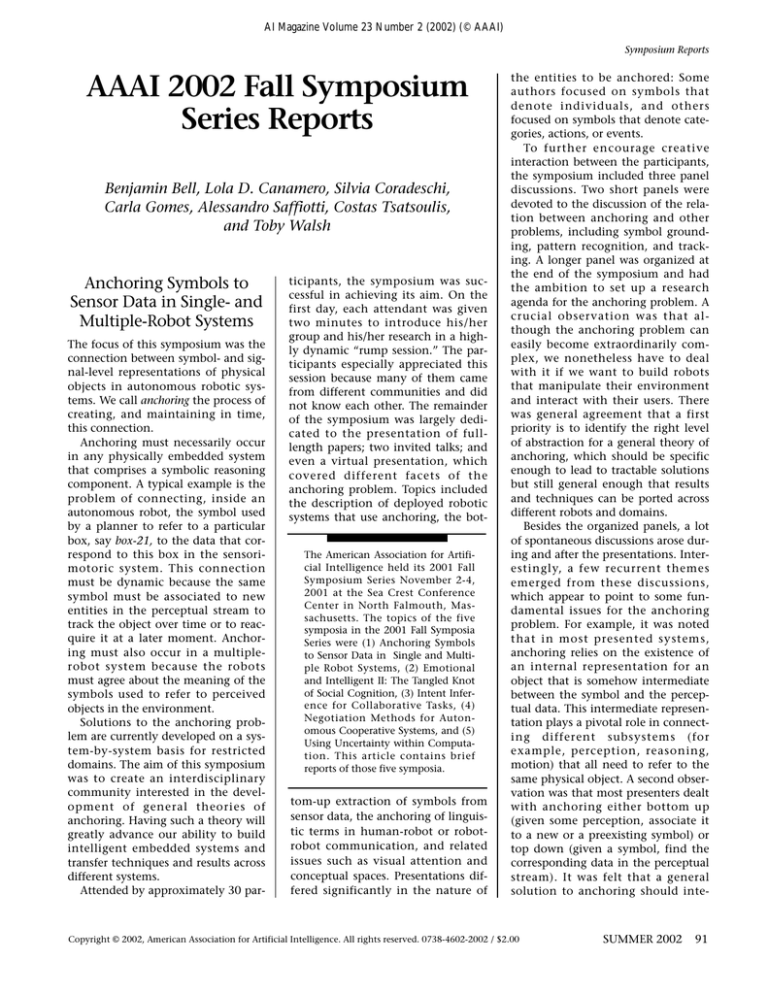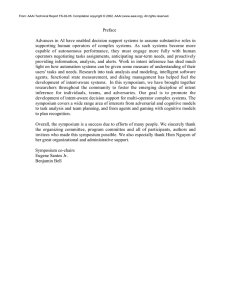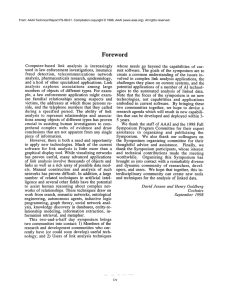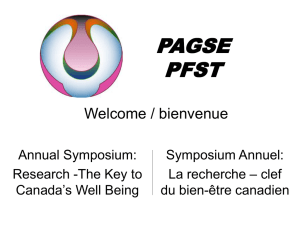
AI Magazine Volume 23 Number 2 (2002) (© AAAI)
Symposium Reports
AAAI 2002 Fall Symposium
Series Reports
Benjamin Bell, Lola D. Canamero, Silvia Coradeschi,
Carla Gomes, Alessandro Saffiotti, Costas Tsatsoulis,
and Toby Walsh
Anchoring Symbols to
Sensor Data in Single- and
Multiple-Robot Systems
The focus of this symposium was the
connection between symbol- and signal-level representations of physical
objects in autonomous robotic systems. We call anchoring the process of
creating, and maintaining in time,
this connection.
Anchoring must necessarily occur
in any physically embedded system
that comprises a symbolic reasoning
component. A typical example is the
problem of connecting, inside an
autonomous robot, the symbol used
by a planner to refer to a particular
box, say box-21, to the data that correspond to this box in the sensorimotoric system. This connection
must be dynamic because the same
symbol must be associated to new
entities in the perceptual stream to
track the object over time or to reacquire it at a later moment. Anchoring must also occur in a multiplerobot system because the robots
must agree about the meaning of the
symbols used to refer to perceived
objects in the environment.
Solutions to the anchoring problem are currently developed on a system-by-system basis for restricted
domains. The aim of this symposium
was to create an interdisciplinary
community interested in the development of general theories of
anchoring. Having such a theory will
greatly advance our ability to build
intelligent embedded systems and
transfer techniques and results across
different systems.
Attended by approximately 30 par-
ticipants, the symposium was successful in achieving its aim. On the
first day, each attendant was given
two minutes to introduce his/her
group and his/her research in a highly dynamic “rump session.” The participants especially appreciated this
session because many of them came
from different communities and did
not know each other. The remainder
of the symposium was largely dedicated to the presentation of fulllength papers; two invited talks; and
even a virtual presentation, which
covered different facets of the
anchoring problem. Topics included
the description of deployed robotic
systems that use anchoring, the botThe American Association for Artificial Intelligence held its 2001 Fall
Symposium Series November 2-4,
2001 at the Sea Crest Conference
Center in North Falmouth, Massachusetts. The topics of the five
symposia in the 2001 Fall Symposia
Series were (1) Anchoring Symbols
to Sensor Data in Single and Multiple Robot Systems, (2) Emotional
and Intelligent II: The Tangled Knot
of Social Cognition, (3) Intent Inference for Collaborative Tasks, (4)
Negotiation Methods for Autonomous Cooperative Systems, and (5)
Using Uncertainty within Computation. This article contains brief
reports of those five symposia.
tom-up extraction of symbols from
sensor data, the anchoring of linguistic terms in human-robot or robotrobot communication, and related
issues such as visual attention and
conceptual spaces. Presentations differed significantly in the nature of
the entities to be anchored: Some
authors focused on symbols that
denote individuals, and others
focused on symbols that denote categories, actions, or events.
To further encourage creative
interaction between the participants,
the symposium included three panel
discussions. Two short panels were
devoted to the discussion of the relation between anchoring and other
problems, including symbol grounding, pattern recognition, and tracking. A longer panel was organized at
the end of the symposium and had
the ambition to set up a research
agenda for the anchoring problem. A
crucial observation was that although the anchoring problem can
easily become extraordinarily complex, we nonetheless have to deal
with it if we want to build robots
that manipulate their environment
and interact with their users. There
was general agreement that a first
priority is to identify the right level
of abstraction for a general theory of
anchoring, which should be specific
enough to lead to tractable solutions
but still general enough that results
and techniques can be ported across
different robots and domains.
Besides the organized panels, a lot
of spontaneous discussions arose during and after the presentations. Interestingly, a few recurrent themes
emerged from these discussions,
which appear to point to some fundamental issues for the anchoring
problem. For example, it was noted
that in most presented systems,
anchoring relies on the existence of
an internal representation for an
object that is somehow intermediate
between the symbol and the perceptual data. This intermediate representation plays a pivotal role in connecting different subsystems (for
example, perception, reasoning,
motion) that all need to refer to the
same physical object. A second observation was that most presenters dealt
with anchoring either bottom up
(given some perception, associate it
to a new or a preexisting symbol) or
top down (given a symbol, find the
corresponding data in the perceptual
stream). It was felt that a general
solution to anchoring should inte-
Copyright © 2002, American Association for Artificial Intelligence. All rights reserved. 0738-4602-2002 / $2.00
SUMMER 2002
91
Symposium Reports
grate both directions. Finally, a question often popped up about whether
we should focus on symbols that correspond to humanlike categories or
symbols that correspond to categories
closer to the robot’s senses. Although
the latter might be an easier starting
point, we will eventually need the
former to have our robots interact
with humans in everyday life.
–Silvia Coradeschi
Alessandro Saffiotti
Orebro University
Emotional and Intelligent
II: The Tangled Knot of
Social Cognition
Three years after the first “tangled
knot” meeting at the 1998 AAAI Fall
Symposium in Orlando, Florida, this
symposium gathered researchers from
different disciplines and backgrounds
to exchange ideas about the roles of
emotions in grounding interpersonal
behaviors and social cognition and to
reflect on the motivations, scientific
grounds, and practical consequences
of our efforts to build artifacts
endowed with emotional capabilities.
Emotions seem to be at the heart of
what being social means. This idea,
however, leads somehow to a Gordian knot: Are we social because we
have emotions, or do we have emotions because we are a highly social
species? Should we rather talk of
coevolution of emotions and sociality? Does this strong link between
emotions, cognition, and sociality
also apply to nonhuman, nonbiological species, that is, artifacts? These
were some of the background questions underlying the different artifacts, models, and theories presented
at the symposium.
Presentations were organized
around five main themes: (1) emotion, social behavior, and learning;
(2) perceiving of others’ emotions
and perceiving of others through
emotions; (3) emotions in decision
making; (4) creating and regulating
of affect with and through artifacts;
and (5) emotions in social behavior
and adaptation.
Five keynote speakers addressed
fundamental topics in various aspects
92
AI MAGAZINE
of emotion research. The psychology
of emotion was represented by
Andrew Ortony, who presented
“Some Thoughts about the Behavioral Concomitants of Emotions,”
and Craig A. Smith, who presented
his work with Leslie Kirby entitled
“On the Elicitation, Differentiation,
and Organization of Emotion: Structural and Procedural Considerations.”
Rosalind Picard addressed a challenging problem in “Machine Recognition of Human Emotions”; John
McCarthy expressed his concerns
about emotional artifacts in “Robots
Can Be Made with Humanlike Emotions but Shouldn’t Be”; and Marvin
Minsky presented some of the
ground-breaking ideas about emotions he has been elaborating over
the last years (and in his forthcoming
book) in “The Emotion Machine: A
Model of Everyday Mental Activity.”
A panel discussion with the participation of Paul Dumouchel, John
McCarthy, Marvin Minsky, Rosalind
Picard, and Craig Smith was held the
afternoon of the second day. It was
entitled “The Impact of Affective
Artifacts on Our Social World.”
The symposium concluded with an
open discussion where some big challenges and directions for future
research in this area were identified.
General consensus was reached about
the benefits (or, rather, the need) of
multidisciplinary efforts involving
human, animal, and artificial emotion researchers. The role of AI and
robotics in these efforts was also the
object of agreement in that far from a
mere implementation of psychological or biological theories about emotion, artificial models of emotions
can provide unprecedented challenges and novel theoretical insights
and have us think in different ways
about issues relevant to emotions and
their roles in social interaction and
cognition. Looking toward the future,
we see the spread of affective artifacts
in our everyday life will also force us
to rethink some of the ways in which
we relate socially and emotionally
with humans and machines.
–Lola Cañamero
Universite Paris-XI
Intent Inference for
Collaborative Tasks
The symposium addressed issues surrounding intent inference, that is,
observing a user’s actions to generate
inferences about the user’s intent.
Strong previous work in the area provided a foundation for the focus of
this symposium, namely, scaling up
intent inference to collaborative contexts, where team activity must be
monitored and analyzed and inferences about team intention generated.
Among our 32 participants were many
of the pioneers of intent inference
applications, 2 of whom offered
keynote addresses to help provide a
set of common reference points for
the discussions. The group as a whole
represented a breadth of disciplines,
giving the conversations a decidedly
multidisciplinary flavor that brought
to the floor concepts from plan recognition, task modeling, work-flow analysis, probabilistic reasoning, natural
language processing, and situated cognition, to name a few. Diversity was
also pronounced in the affiliations of
the participants, which reflected a balance of academic, industrial, and government organizations.
In her keynote talk, Christine
Mitchell from the Georgia Institute of
Technology provided a survey of a
cluster of related research initiatives
that use some form of activity tracking in generating inferences of user
intention. Norm Geddes of Applied
Systems Intelligence emphasized in
his keynote talk the challenges of
scaling up previous approaches to
large-scale intent inference systems
(for example, the NATIONAL AIR SPACE).
The presentations offered a noticeable breadth of ideas and examples;
we learned about intent inference
applications in process control, flight
operations, command and control,
and mobile commerce, for example.
Investigators approached these problems from a range of disciplines and
experimental methodologies, which
enriched each participant’s experience and kept the interchange lively.
Among the many areas of ongoing
work our participants will continue
to address are adversary intent inference, which shifts the modeling fo-
Symposium Reports
AIPS-2002—Tolouse, France
Proceedings of the Sixth International
Conference on Artificial Intelligence
Planning and Scheduling Systems
Edited by Malik Ghallab, Joachim Hertzberg,
& Paolo Traverso
The 2002 proceedings papers span a wide range of topics, including papers that address real-world
problems, bridge the gap between theory and practice, and effectively combine planning and scheduling with other areas of computer science. Many contributions focus on extending the state of the art
and the rational foundations for critical issues such as interactive or mixed-initiative planning,
dynamic planning, and uncertainty or incompleteness in planning.
ISBN 1-57735-142-8, $65.00 softcover
Available in July 2002
www.aaai.org/Press/
cus from the user or team to a hostile
agent; intent-driven information
retrieval and information extraction;
and intent inference for mixed-initiative, human-agent collaboration.
By bringing together researchers
from the intent inference community, those engaged in the study of collaboration, and prominent players in
the application domains, this symposium succeeded in advancing an
important dialogue. We have established a listserv for those interested in
joining this discussion; visit www.
coral.cs.cmu.edu/mailman/listinfo/ag
entmod-l to subscribe.
–Benjamin Bell
Lockheed Martin
Negotiation Methods
for Autonomous
Cooperative Systems
Negotiation is one important mechanism through which groups of
autonomous systems can reach agreement, in a distributed fashion, on the
sharing of limited resources or the
allocation of tasks. Through negotiation, groups can form cooperative
teams, in a bottom-up fashion, to
resolve a variety of constraint-satisfaction problems. Such systems are
typically characterized by (1) decentralized control, (2) partial and uncertain information, (3) and some sort
of real-time constraint on resource or
task allocation.
The symposium focused on three
major topics over three days: The first
day was dedicated to presentations
and panels that discussed how negotiation could be used for the cooperative allocation of resources, especially
in domains of soft or hard real-time
constraints. The discussions centered
on both theoretical and implementational issues of negotiation-based
constraint satisfaction and resource
and task allocation. Applications
mentioned include sensor management for tracking and mission planning for unmanned aircraft.
The second day’s presentations
concentrated on theoretical issues
and strategies of negotiation. Papers
presented included studies of phase
transition in games that model negotiation, ways of expressing and modeling preferences, and market models
of negotiation. The panel discussion
concentrated on how these theoretical approaches can be transitioned to
more complex negotiation systems
and protocols and how they can
assist in the quality of the final solution achieved by the negotiating
cooperative system.
The final half-day of the symposium looked at individualistic negotiation models and discussed whether
and how these models could be
applied to cooperative negotiation
environment. The final panel (entitled
“Negotiation versus the World: What’s
the Relationship of Negotiation Technology to Better-Known Technologies?”) focused on why negotiation is
needed and the types of problems
where it can provide solutions that are
better than those provided by other
reasoning techniques. The panel
raised more questions than it
answered, and there was much discussion on the future of negotiation.
In addition to the paper presentations and the discussion panels, the
symposium participants enjoyed two
invited talks by Sarit Kraus and Sesh
Murthy. Kraus concentrated on negotiation for dispute resolution, and
Murthy presented various applica-
SUMMER 2002
93
Symposium Reports
Advances in Knowledge Discovery and Data Mining
Edited by Usama M. Fayyad, Gregory Piatetsky-Shapiro, Padhraic Smyth, and Ramasamy Uthurusamy
Advances in data collection, widespread use of bar codes, and the computerization of many transactions have flooded us with information and
generated an urgent need for techniques and tools that can intelligently and automatically assist us in transforming these data into useful knowledge. This book examines and describes many such new techniques and tools in the field of data mining and knowledge discovery in databases.
The chapters in this book span fundamental issues of knowledge discovery, classification and clustering, trend and deviation analysis, dependency derivation, integrated discovery systems, augmented database systems, and application case studies.
ISBN 0-262-56097-6
625 pp., illus., references, index
Advances in Distributed and Parallel Knowledge Discovery
Edited by Hillol Kargupta and Philip Chan
Knowledge discovery and data mining (KDD) deals with the problem of extracting interesting associations, classifiers, clusters, and other
patterns from data. The emergence of network-based distributed computing environments has introduced an important new dimension to
this problem—distributed sources of data. Traditional centralized KDD typically requires central aggregation of distributed data, which
might not always be feasible because of limited network bandwidth, security concerns, scalability problems, and other practical issues. Distributed knowledge discovery (DKD) works with the merger of communication and computation by analyzing data in a distributed fashion. This technology is particularly useful for large heterogeneous distributed environments such as the internet, intranets, mobile computing environments, and sensor networks. When the data sets are large, scaling up the speed of the KDD process is crucial. Parallel knowledge
discovery (PKD) techniques address this problem by using high-performance multiprocessor machines. This book presents introductions
to DKD and PKD, extensive reviews of the field, and state-of-the-art techniques.
ISBN 0-262-61155-4
472 pp., illus., bibliography, index
Published by AAAI Press • www.aaai.org/Press/
tions of negotiation to business-tobusiness environments.
–Costas Tsatsoulis
The University of Kansas
Using Uncertainty
within Computation
We are witnessing an increasing
interest in approaches based on randomization, probability, and uncertainty to speed up computation,
model resources more realistically,
and reason about complex systems.
This symposium brought together
researchers interested in this new area
of research, bridging different areas of
AI such as constraint programming,
decision theory, flexible computation, knowledge representation and
reasoning, learning, planning, probabilistic reasoning and probabilistic
analysis of algorithms, qualitative
reasoning, randomized algorithms,
reasoning under uncertainty, and
search.
There were four focus areas in the
symposium: (1) algorithm selection
94
AI MAGAZINE
and scheduling, (2) combinatorial
search, (3) modeling uncertainty, and
(4) applications. We were pleased to
have Rina Dechter as an invited speaker. She gave a fascinating talk in which
she explored the interface between
constraint processing and Bayesian
networks, between inference methods
and probabilistic reasoning.
The methods used to boost search
and deal with uncertainty discussed
at the symposium ranged from the
simple, for example, expectations
and intervals, to the complex, for
example, algorithm portfolios,
Bayesian learning, and stochastic
constraint programming. Search
methods discussed included both
local search and global (complete)
search methods. The domains and
applications presented at the symposium included randomized dispatch
scheduling, reasoning across scenarios in planning under uncertainty,
methods for sampling pages from the
World Wide Web uniformly, temporal
mechanisms for decision making in
probabilistic networks, and stochastic
context-free grammars.
The meeting included an interesting panel session entitled “Future of
Uncertainty within Computation”:
Issues such as modeling and dealing
with risk and trading off search by
inference were featured extensively. It
was recognized that this area of
research is new, explicitly studying
and developing methods based on
randomization and uncertainty in
general to boost our ability to model
and reason about complex systems;
nevertheless, we have only simple
mechanisms that work, such as
restarts within our algorithms. Our
research agenda is more ambitious
than that, and in the future, we will
embrace uncertainty and build complex adaptive algorithms that cope
with uncertainty. Overall, this is an
exciting research area with tremendous potential for innovation in
areas such as algorithm design and
formal modeling of complex systems.
–Carla Gomes
Cornell University
–Toby Walsh
York University





